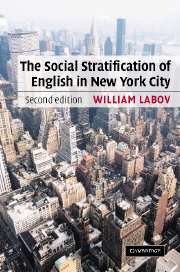Book contents
- Frontmatter
- Contents
- Introductory note
- Preface to the first edition
- Preface to the second edition: forty years later
- I Problems and methods of analysis
- 1 The study of language in its social context
- 2 First approach to the structure of New York City English
- 3 The social stratification of (r) in New York City department stores
- 4 The isolation of contextual styles
- 5 The linguistic interview
- 6 The survey of the Lower East Side
- II Social differentiation
- III Social evaluation
- IV Synthesis
- Glossary of linguistic symbols and terminology
- Appendix A Questionnaire for the ALS Survey
- Appendix B Anonymous observations of casual speech
- Appendix C Analysis of losses through moving of the MFY sample population
- Appendix D Analysis of the non-respondents: the television interview
- Appendix E The out-of-town speakers
- Bibliography
- Index
4 - The isolation of contextual styles
Published online by Cambridge University Press: 18 December 2009
- Frontmatter
- Contents
- Introductory note
- Preface to the first edition
- Preface to the second edition: forty years later
- I Problems and methods of analysis
- 1 The study of language in its social context
- 2 First approach to the structure of New York City English
- 3 The social stratification of (r) in New York City department stores
- 4 The isolation of contextual styles
- 5 The linguistic interview
- 6 The survey of the Lower East Side
- II Social differentiation
- III Social evaluation
- IV Synthesis
- Glossary of linguistic symbols and terminology
- Appendix A Questionnaire for the ALS Survey
- Appendix B Anonymous observations of casual speech
- Appendix C Analysis of losses through moving of the MFY sample population
- Appendix D Analysis of the non-respondents: the television interview
- Appendix E The out-of-town speakers
- Bibliography
- Index
Summary
Linguists have never been unconscious of the problems of stylistic variation. The normal practice is to set such variants aside – not because they are considered unimportant, but because the techniques of linguistics are not thought to be suitable or adequate to handle them. Structural analysis is normally the abstraction of those unvarying, functional units of language whose occurrence can be predicted by rule. Since the influence of stylistic conditioning on linguistic behavior is said to be merely statistical, it can only lead to statements of probability rather than rule.
For the present purposes, I would rather say that stylistic variation has not been treated by techniques accurate enough to measure the extent of regularity which does prevail. The combination of many stylistic factors imposed upon other influences may lead to seemingly erratic behavior; but this apparent irregularity is comparable to the inconsistencies which seemed to govern the historical development of vowels and consonants until some of the more subtle conditioning factors were perceived.
At the end of Chapter 3, it was suggested that the five phonological variables show regular variation through different styles and contexts in the speech of New Yorkers. The problem now is to control the context, and define the styles of speech which occur within them, so that this hypothesis can be tested.
- Type
- Chapter
- Information
- The Social Stratification of English in New York City , pp. 58 - 86Publisher: Cambridge University PressPrint publication year: 2006



